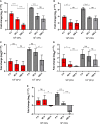Innate Immune Responses of Galleria mellonella to Mycobacterium bovis BCG Challenge Identified Using Proteomic and Molecular Approaches
- PMID: 33634038
- PMCID: PMC7900627
- DOI: 10.3389/fcimb.2021.619981
Innate Immune Responses of Galleria mellonella to Mycobacterium bovis BCG Challenge Identified Using Proteomic and Molecular Approaches
Abstract
The larvae of the insect Galleria mellonella, have recently been established as a non-mammalian infection model for the Mycobacterium tuberculosis complex (MTBC). To gain further insight into the potential of this model, we applied proteomic (label-free quantification) and transcriptomic (gene expression) approaches to characterise the innate immune response of G. mellonella to infection with Mycobacterium bovis BCG lux over a 168 h time course. Proteomic analysis of the haemolymph from infected larvae revealed distinct changes in the proteome at all time points (4, 48, 168 h). Reverse transcriptase quantitative PCR confirmed induction of five genes (gloverin, cecropin, IMPI, hemolin, and Hdd11), which encoded proteins found to be differentially abundant from the proteomic analysis. However, the trend between gene expression and protein abundance were largely inconsistent (20%). Overall, the data are in agreement with previous phenotypic observations such as haemocyte internalization of mycobacterial bacilli (hemolin/β-actin), formation of granuloma-like structures (Hdd11), and melanization (phenoloxidase activating enzyme 3 and serpins). Furthermore, similarities in immune expression in G. mellonella, mouse, zebrafish and in vitro cell-line models of tuberculosis infection were also identified for the mechanism of phagocytosis (β-actin). Cecropins (antimicrobial peptides), which share the same α-helical motif as a highly potent peptide expressed in humans (h-CAP-18), were induced in G. mellonella in response to infection, giving insight into a potential starting point for novel antimycobacterial agents. We believe that these novel insights into the innate immune response further contribute to the validation of this cost-effective and ethically acceptable insect model to study members of the MTBC.
Keywords: Galleria mellonella; Mycobacterium bovis BCG; gene expression; in vivo model; innate immunity; proteomics; tuberculosis.
Copyright © 2021 Asai, Sheehan, Li, Robertson, Kavanagh, Langford and Newton.
Conflict of interest statement
The authors declare that the research was conducted in the absence of any commercial or financial relationships that could be construed as a potential conflict of interest.
Figures






Similar articles
-
Systematic review of innate immune responses against Mycobacterium tuberculosis complex infection in animal models.Front Immunol. 2025 Jan 30;15:1467016. doi: 10.3389/fimmu.2024.1467016. eCollection 2024. Front Immunol. 2025. PMID: 39949719 Free PMC article.
-
Galleria mellonella - a novel infection model for the Mycobacterium tuberculosis complex.Virulence. 2018;9(1):1126-1137. doi: 10.1080/21505594.2018.1491255. Virulence. 2018. PMID: 30067135 Free PMC article.
-
A novel biosafety level 2 compliant tuberculosis infection model using a ΔleuDΔpanCD double auxotroph of Mycobacterium tuberculosis H37Rv and Galleria mellonella.Virulence. 2020 Dec;11(1):811-824. doi: 10.1080/21505594.2020.1781486. Virulence. 2020. PMID: 32530737 Free PMC article.
-
Use of the Invertebrate Galleria mellonella as an Infection Model to Study the Mycobacterium tuberculosis Complex.J Vis Exp. 2019 Jun 30;(148). doi: 10.3791/59703. J Vis Exp. 2019. PMID: 31305513
-
Galleria mellonella Larvae as a Model for Investigating Fungal-Host Interactions.Front Fungal Biol. 2022 Apr 26;3:893494. doi: 10.3389/ffunb.2022.893494. eCollection 2022. Front Fungal Biol. 2022. PMID: 37746216 Free PMC article. Review.
Cited by
-
Galleria mellonella-intracellular bacteria pathogen infection models: the ins and outs.FEMS Microbiol Rev. 2023 Mar 10;47(2):fuad011. doi: 10.1093/femsre/fuad011. FEMS Microbiol Rev. 2023. PMID: 36906279 Free PMC article. Review.
-
Studies of Streptococcus anginosus Virulence in Dictyostelium discoideum and Galleria mellonella Models.Infect Immun. 2023 May 16;91(5):e0001623. doi: 10.1128/iai.00016-23. Epub 2023 Apr 25. Infect Immun. 2023. PMID: 37097148 Free PMC article.
-
Galleria mellonella-A Model for the Study of aPDT-Prospects and Drawbacks.Microorganisms. 2023 May 31;11(6):1455. doi: 10.3390/microorganisms11061455. Microorganisms. 2023. PMID: 37374956 Free PMC article. Review.
-
Systematic review of innate immune responses against Mycobacterium tuberculosis complex infection in animal models.Front Immunol. 2025 Jan 30;15:1467016. doi: 10.3389/fimmu.2024.1467016. eCollection 2024. Front Immunol. 2025. PMID: 39949719 Free PMC article.
-
Galleria mellonella as an infection model for the virulent Mycobacterium tuberculosis H37Rv.Virulence. 2022 Dec;13(1):1543-1557. doi: 10.1080/21505594.2022.2119657. Virulence. 2022. PMID: 36052440 Free PMC article.
References
Publication types
MeSH terms
Substances
Grants and funding
LinkOut - more resources
Full Text Sources
Other Literature Sources
Molecular Biology Databases
Miscellaneous

